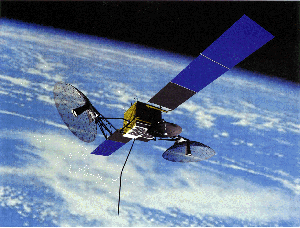TDRSS

TDRS-H, -I, -J.
TDRSS (Tracking and Data Relay Satellite System) is a constellation of geosychronous communications satellites, each called a Tracking and Data Relay Satellite (TDRS), which, together with ground support facilities, is used for communications to and from the Space Shuttle, US portions of the International Space Station, and many unmanned low Earth orbiting NASA spacecraft, including Aura, the Compton Gamma Ray Observatory, Gravity Probe B, the Hubble Space Telescope, Landsat, TOPEX-Poseidon, and Wilkinson Microwave Anisotropy Probe. In addition, TDRSS provides data relay services to Antarctic facilities, such as McMurdo Station, by way of the TDRSS South Pole Relay, and launch data relay for expendible boosters, including Atlas IIA and rockets launched from the Sea Launch platform.
The first TDRS was launched in 1983 on the Space Shuttle Challenger's first flight, STS-6. The Inertial Upper Stage intended to lift the satellite to geostationary orbit didn't work properly, as a result of which TDRS 1 had to use its onboard thrusters to reach its correct orbit. This reduced its operational lifetime, and it has since been reduced to part-time duty supporting Antarctic communications. The second vehicle in the series was lost in the Challenger disaster and later replaced by TDRS-7.
TDRS 1 through 7 were built by TRW, and TDRS 8(H), 9(I), and 10(J) by Boeing's Satellite Systems. Each satellite has S-band and Ku-band systems (see frequency bands), which support multiple data-rates. The newer Boeing satellites replicate all of the services of the older TRW-built satellites and provide some additional ones as well, notably enhanced multiple access (MA) capability and Ka-band service.
When first launched, the TDRS satellites were the largest, most sophisticated communications satellites ever built. Each has a maximum diameter of 3.4 meters when stowed and measure 21 x 13 meters with solar panels deployed. The on-orbit mass of TDRS-H through -J is about 1,780 kilograms.
The TDRSS ground segment is located near Las Cruces, New Mexico, and consists of two functionally identical ground terminals collectively known as the White Sands Complex. Customer forward data is uplinked from the ground segment to the TDRS and from the TDRS to the customer spacecraft. Return data is downlinked from the customer spacecraft via the TDRS to the ground segment and then on to the customer designated data collection location.
| spacecraft | launch date | launch vehicle | GSO location |
| TDRS 1 | Apr 4, 1983 | Shuttle STS-6 | 49° W |
| TDRS 3 | Sep 29, 1988 | Shuttle STS-26 | 275° W |
| TDRS 4 | Mar 13, 1989 | Shuttle STS-29 | 41° W |
| TDRS 5 | Aug 2, 1991 | Shuttle STS-43 | 174° W |
| TDRS 6 | Jan 13, 1993 | Shuttle STS-54 | 47° W |
| TDRS 7 | Jul 13, 1995 | Shuttle STS-70 | 150° W |
| TDRS 8 (H) | Jan 30, 2000 | Atlas IIA | 171.5° W |
| TDRS 9(I) | Mar 8, 2002 | Atlas IIA | 170° W |
| TDRS 10(J) | Dec 5, 2002 | Atlas IIA | 150.7° W |


